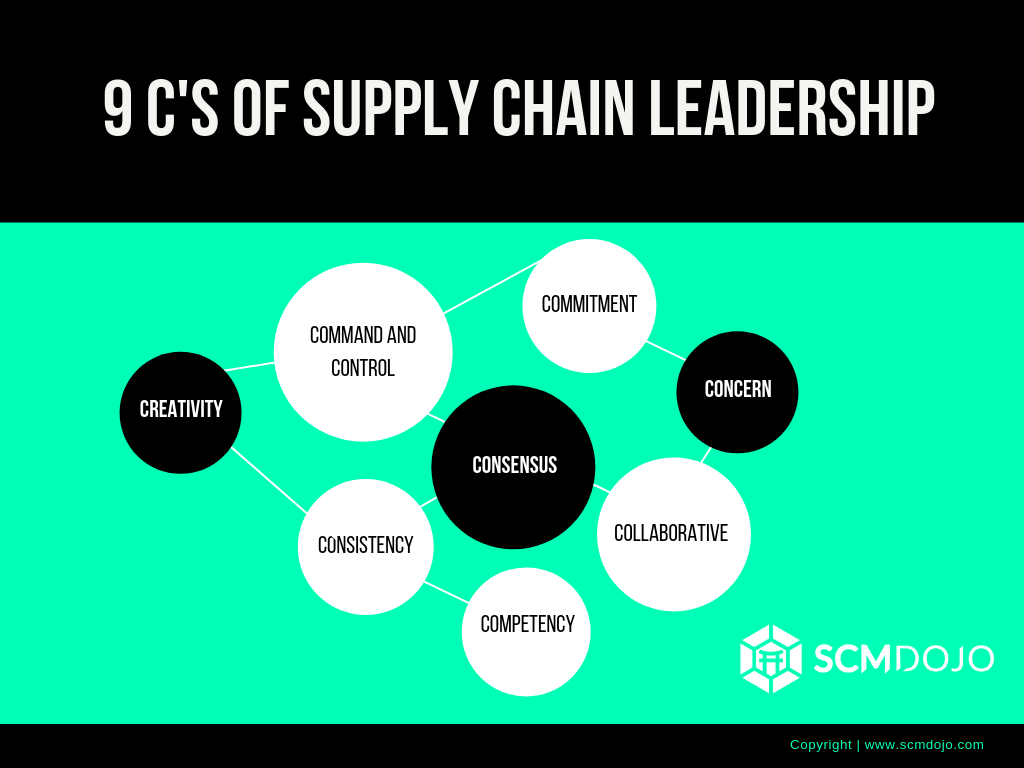The importance of effective supply chain leadership in the success of a business is clearly more defined nowadays. Whether you run a small, medium or multi-national/conglomerate across the globe, you need a supply chain leadership style that will effectively cover the end to end supply chain and motivate people.
Leadership itself is complex and very well research topics over the years. One of the most extensive documents I have seen is by The Korn Ferry Leadership Architect ™. The document is based on a review of more recent literature, consideration of key 21st-century trends, and insights from our data, which is comprised of 4 Factors, 12 Clusters, and 38 Competencies. These leadership competencies when combined with supply chain technical competences, it should create a well-rounded supply chain leader in my opinion.
A supply chain leader who can demonstrate both soft skills and technical knowledge is required to lead supply chain teams.
Supply chain leadership roles have evolved over the past years, today it is more than having practical knowledge, but to be able to process a situation and manage a team from start to finish, to improve productivity, and makes a profit for the company.
Supply Chain is getting more and more complex. The requirement of increased visibility, agility, flexibility, risk mitigation, technological innovation and ever-growing expectation from customers for excellence is a huge challenge for supply chain managers and leaders. This challenging environment requires supply chain managers and leaders to adopt certain effective habits and leadership skills.
This blog is inspired by my observation of effective supply chain leaders and recent video I have seen by Professor Richard Wilding OBE – Supply Chain Leadership: Choose the Right Style! – An executive insight.
9’C of Supply Chain Leadership Every Leader Should Master
According to Professor Richard Wilding OBE, leadership is about people or managers that are aiming to create a definite path, alignment, and commitment within a team or the team they are responsible for.
Being an effective supply chain leadership is very challenging as a company’s supply chain works in two directions both of which has to complement each other to function properly.
For example, Mode One supply chain allows supply chain leaders to focus on predictability, being moderate is essential to cost reduction, managing further prediction and ability to reduce the risks involved in a supply chain.
In Mode two supply chain, leaders focus on speed and fast track strategies to be able to solve unforeseen problems or incorporating new ideas and technologies. To say you have the qualities of a supply chain leadership, leaders must understand these two modes and how to manage them both effectively.
For these reasons, companies need leaders to lead differently but to also adapt supply chain leadership styles that can combine both modes. With that said, there are 4 styles which must be adopted.
These are command, control, consensus, and collaborative supply chain leadership style; among this first four Cs, the leader must choose which work best in the different modes.
Command and Control
We are taking these two styles together as it is difficult to separate control from command and vice versa.
In this supply chain leadership style, leaders work with a defined order where everything is well structured and arranged, but this style fails in a complex organization where innovation is important.
Supply chain leadership skills can help leaders reduce the loses on a supply chain as they are able to
- Effectively manage every team on the supply chain like the manufacturers, contractors, vendors, suppliers, etc.
- Are able to share information and resources
- Rely on predictive analytics to see the direction the supply chain is heading
- Can make an impromptu decision with the aid of innovation
Consensus
Consensus on the other hand work in an organization where the staff is grouped into small teams that manage a particular task before the final result is drafted
This style of supply chain leadership, however, doesn’t seem to do so well where speed is of paramount importance due to the different work speed in the teams.
Collaborative Supply Chain Leadership
When diverse teams come together to solve a problem, collaborative leadership style is more suitable, For a supply chain leader, the ability to manage effectively different departments across an organization also requires a collaborative supply chain leadership skill.
Collaborative leadership works excellently well when leaders have to deal with a large number of teams across different sections in a company, and most especially when technology and creativity are necessary to push an idea forward.
Hence, in my experience for large corporations with matrix organisation structure, collaborative supply chain leadership style works best.
Although this is hard, a good leader should be able to manage the teams/group to create better alignment and make the team more committed to the process at hand.
Watch the full video of Professor Richard Wilding OBE below.
The next sets of 4 Cs are as follows:
Competency
Leaders are naturally expected to be competent; it is demand skill set that most companies and establishment desire but what does it really mean for a supply chain leader to be competent.
Competency in supply chain means continually learning and remonstrating relevant knowledge and expertise, mostly in these technical competencies.
Assess Your Materials Management Competencies
When a supply chain leadership is defined as competent or is said to exhibit a level of competency, it means they are not measured by what they rather what he/she can do can accomplish by what they do. Hence, in a nutshell, competency is never settling for good or average but pushing for the best and also been able to produce outstanding results from situations that are otherwise termed impossible.
Consistency
This one is the hardest to master over a long period of time, as multiple intervening factors affect the consistent performance over the long period of time.
In simple terms consistency means, doing what you say you will do over time.
In the supply chain leadership skill, the ability for a leader to develop a habit that provokes success in him or his team is consistency.
For a supply chain leader who wants to master consistency should be able to
- Builds trust and credibility along with the peers, suppliers, and customers.
- Builds trust and credibility along with the peers, suppliers, and customers.
- With consistency, you are able to predict the results and behaviors
- Consistency achieves goals and delivers on expectations
- Consistency builds the reputation and brand you are!
Although consistency takes dedication, it is an important skill every supply chain leader must practice to endure results are delivered on target.
Commitment
Commitment for me is the famous scene by Rocky Balboa “It Ain’t Over ‘Til It’s Over”. In other words, commitment is persevering to achieve goals despite obstacles and setbacks
Great leaders come and go every day in organizations around the world, but committed leaders become a household name and an idol who others follow to become excellent supply chain leaders.
When we talk of commitment for a supply chain leadership, it signifies that the leader possesses all the Cs mentioned above. Commitment breeds productivity and efficiency in a team and boosts the staff morale to deliver results regardless of the storm ahead. Some attributes of a committed supply chain leaders are:
- They are communicators and are able to communicate a message, idea or thought clearly without any ambiguities to the rest of the employees
- They are accountable in all their dealings with staffs in the office or outside the office
- They are solution providers and are able to take effective decision in the wake of any issues without shifting blames to other team members
- They are able to efficiently organize and manage the supply chain keeping every step under control and delivering an excellent end result
- They are charismatic, disciplined and have a firm hold on their supply chain leadership role showing exceptional resilience and excellent leadership skill
When a supply chain leadership shows commitment in their job, they rank in all areas including operation and innovation but also show excellent leadership ability in handling social responsibility and social affairs.
Concern for the People
Emotional Intelligence is discussed a lot these days in the leadership domain and empathy or concern of people is a big part of the time.
A concern in leadership is genuinely demonstrating sensitivity to the thoughts, feelings, and experience of others.
In the supply chain, we mostly manage ‘information flow’ to manage ‘material flow’. This information flow is mostly managed by people. So, for most supply chain teams, the investment in people represents a significant proportion of all investments.
Showing empty and concern takes a genuine effort, when done properly it has a lever that has the potential of any supply chain team to acquire excellence and maintain it.
I would recommend you to follow and read articles by Dr. Travis Bradberry on Linkedin, who is champion of emotional intelligence.
Supply chain leadership plays a crucial and essential role in the maximizing the abilities of their employees for the benefit of all – company and staff. In a supply chain operation, every single decision you make impact everyone on that chain either directly or indirectly.
To truly exhibit the qualities of a supply chain leader is to be able to leverage on the potentials of all sectors in developing a program or medium where everybody is happy.
Creativity
Last but not least, we as supply chain leader must master being creative. Today’s supply chain challenges force us to think outside the box on the feet. Creativity was always an integral part of any business even though it was never given the necessary importance in companies.
Creativity is an essential part of is entrepreneurship or intrapreneurship and more important for a supply chain leadership personnel as it enables them to get new businesses, sustain old ones and device mean to take the company to greater heights.
Although creativity has never been core topic in supply chain domain, perhaps due to the inability to pinpoint what it is at a particular time; it is the ability to think up ideas that will improve the general working environment but also generate profitability for the company.
The roles of a supply chain leadership are to be able to incorporate the effective management of people and logistics through utilizing appropriate information, market trends, data and systems to produce results.
The above 9 Cs is the skills that every leader should adopt for the success of the supply chain in any company.
Supply chain leadership strategies are the backbone for the success of any business operation hence the need to breed supply chain leadership structures that will effectively create proper market coverage, make available the products and be the key to generating revenue.
So if you add one more C in Supply Chain Leadership Model, what it would be?
Recommended Reading
Strategic Supply Chain Management: The Five Core Disciplines for Top Performance, Second Editon
About the Author- Dr Muddassir Ahmed
Dr MuddassirAhmed is the Founder & CEO of SCMDOJO. He is a global speaker, vlogger and supply chain industry expert with 17 years of experience in the Manufacturing Industry in the UK, Europe, the Middle East and South East Asia in various Supply Chain leadership roles. Dr. Muddassir has received a PhD in Management Science from Lancaster University Management School. Muddassir is a Six Sigma black belt and founded the leading supply chain platform SCMDOJO to enable supply chain professionals and teams to thrive by providing best-in-class knowledge content, tools and access to experts.
You can follow him on LinkedIn, Facebook, Twitter or Instagram








